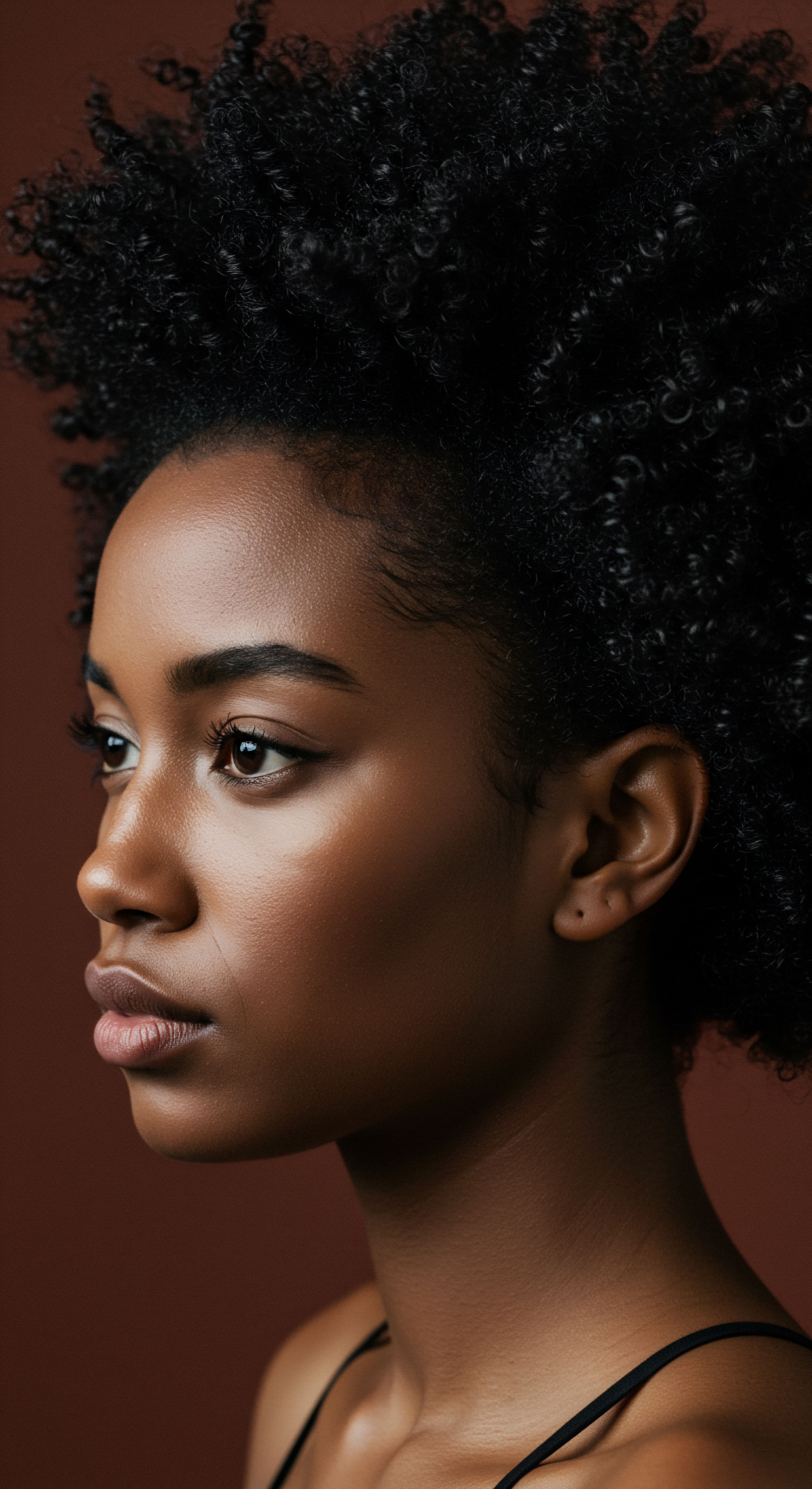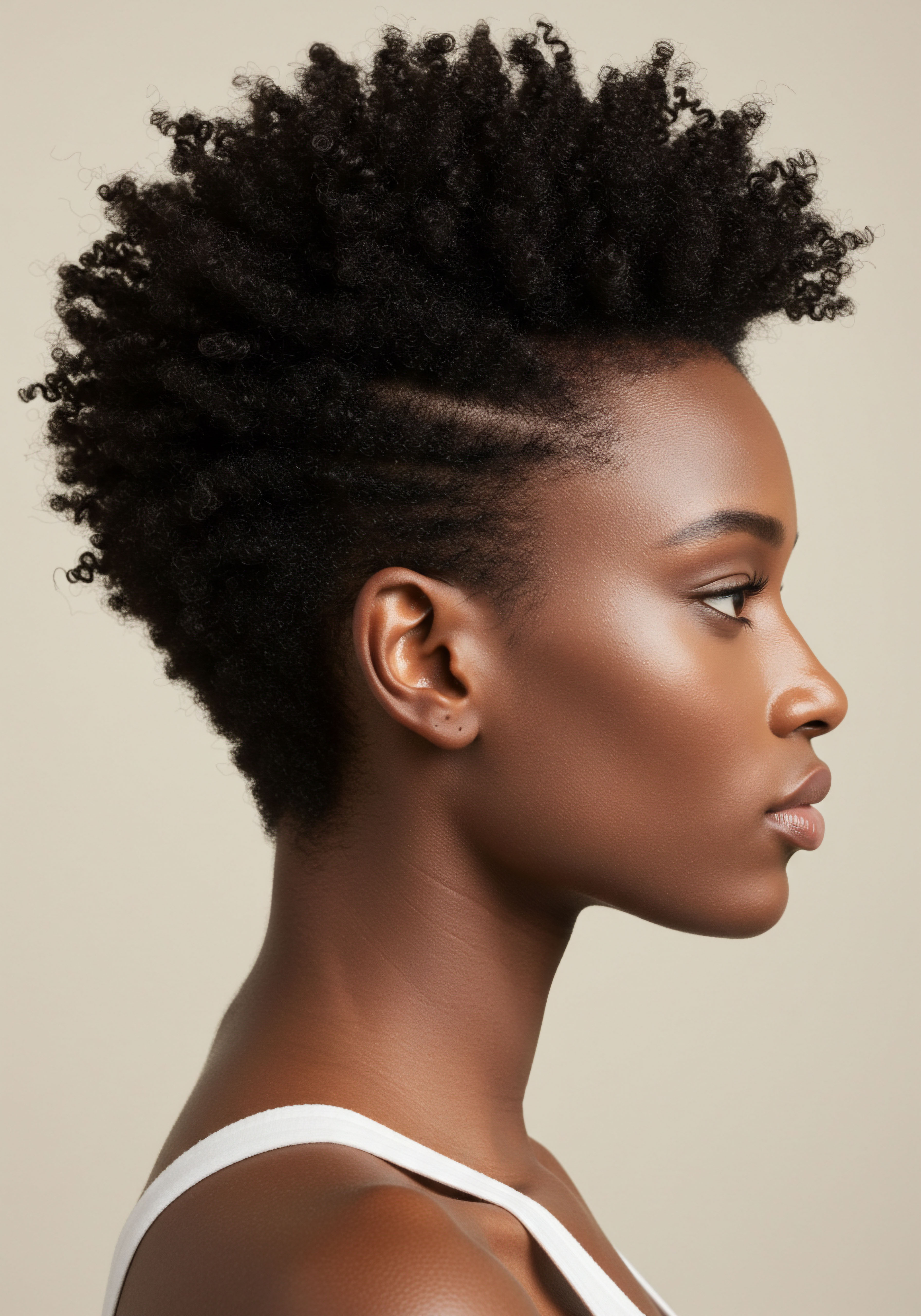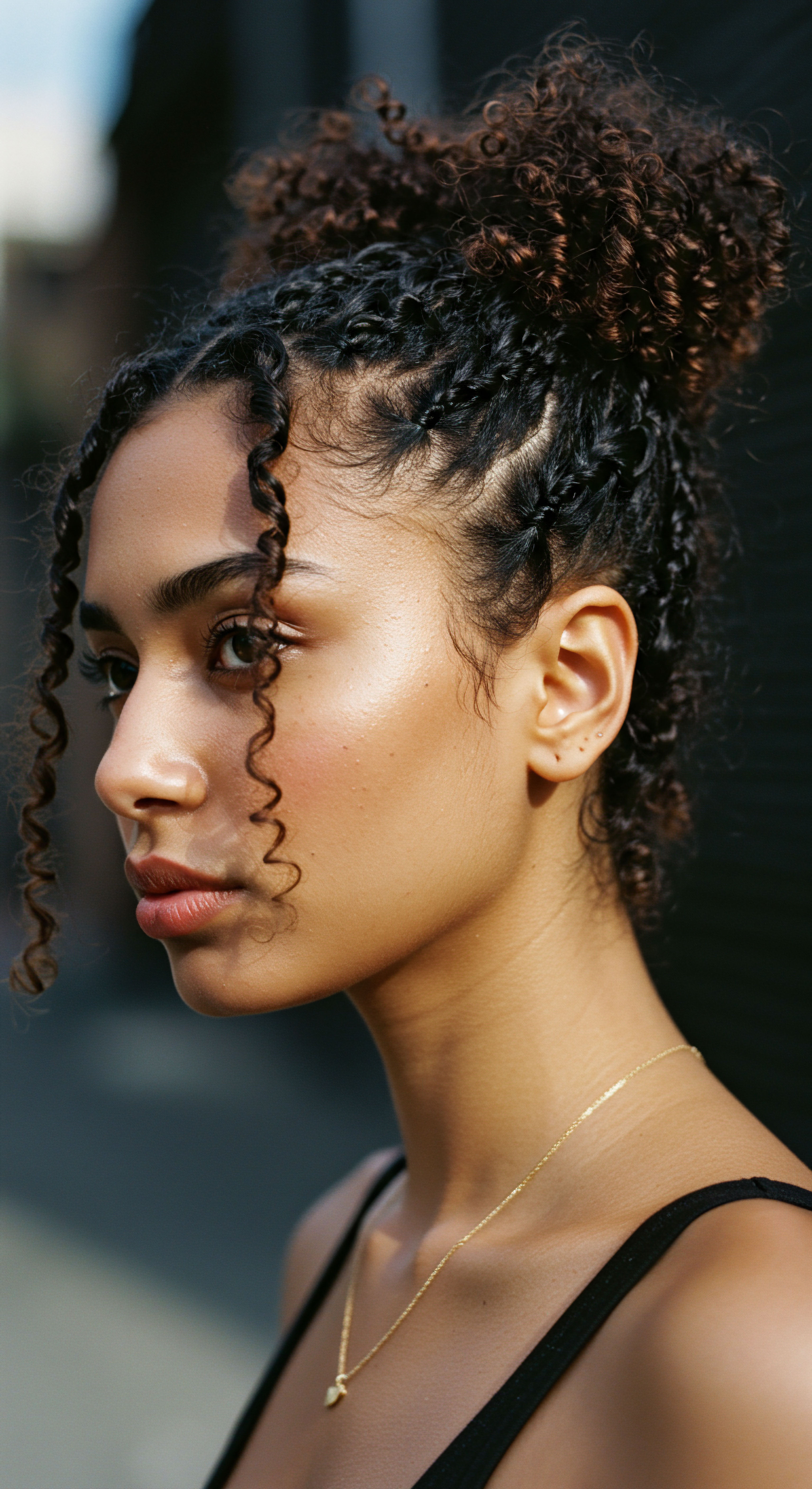
Roots
A quiet inquiry often surfaces when discussing textured hair ❉ why does its nighttime care hold such profound importance? This question, seemingly simple, opens a doorway to understanding the very foundations of these remarkable strands. It invites us to consider not just a routine, but a relationship with our hair, one built on the unique properties gifted by heritage and biology.
At Roothea, we see this as an invitation to delve into the elemental truths that shape the daily experiences of those with coils, curls, and kinks. It is about appreciating the intrinsic qualities that call for a gentle, knowing hand, particularly as the day fades into night.

Hair’s Inner Structure and Outer Form
Every hair strand, regardless of its outer appearance, shares a fundamental biological blueprint, yet distinct variations sculpt its ultimate form and behavior. The outermost layer, the Cuticle, comprises overlapping scales, much like shingles on a roof, protecting the inner cortex and medulla. Beneath this protective shield, the Cortex accounts for the bulk of the hair’s mass, holding the pigment that gives hair its color and contributing significantly to its strength and elasticity. The innermost core, the Medulla, is not always present in every hair type or even along the entire length of a single strand.
For hair of African descent, these structural components possess specific characteristics that distinguish them. The hair shaft itself often presents an Elliptical or Flattened Cross-Section, rather than the more circular shape seen in Asian hair or the oval shape of Caucasian hair. This distinctive shape, coupled with frequent twists and turns along the strand’s length, creates inherent points of weakness and areas where the cuticle may not lie as flatly. This unique geometry means that the cuticle scales can be more prone to lifting, rendering the hair more susceptible to external aggressors and moisture loss.

The Language of Hair Types
To truly understand textured hair, a precise lexicon becomes essential. We speak of Curl Pattern, ranging from wavy to tightly coiled, often categorized using numerical and alphabetical systems that describe the shape and tightness of the curl. Hair Density refers to the number of individual hair strands on the scalp, while Strand Diameter describes the thickness of a single hair. These terms are not mere descriptors; they are keys to comprehending how each head of hair interacts with its environment and responds to care.
For instance, African hair generally exhibits a lower density of hair follicles compared to Caucasian hair, with an average of 90,000 follicles versus 120,000. This lower density means that while tightly coiled hair can appear voluminous, individual strands are often finer, and the scalp can be more visible if breakage occurs. This reality underscores the importance of minimizing any factor that could compromise strand integrity.
The intrinsic architecture of black hair, characterized by its unique elliptical shape and natural coiling, predisposes it to a greater need for protective care, particularly during periods of rest.

Cycles of Growth and Influencing Factors
Hair growth proceeds through distinct phases ❉ the Anagen Phase (active growth), the Catagen Phase (transitional), and the Telogen Phase (resting). The duration of the anagen phase largely determines hair length. While all human hair follows this cycle, the growth rate for Afro-ethnic hair tends to be slower, averaging around 0.9 cm per month compared to approximately 1.3 cm per month for Caucasian hair. This slower growth rate, combined with an increased propensity for breakage, can make length retention a significant challenge for individuals with textured hair.
Many factors beyond genetics sway hair health. Environmental elements, such as humidity and UV radiation, can strip moisture and damage the cuticle. Chemical treatments, like relaxers or colorants, fundamentally alter the hair’s structure, increasing its fragility.
Even daily manipulation, such as combing or styling, contributes to wear and tear. Recognizing these influences is the first step toward building a care routine that champions the hair’s inherent resilience.
| Characteristic Cross-Section Shape |
| African Hair Elliptical, Flattened |
| Caucasian Hair Oval, Intermediate |
| Asian Hair Circular, Larger Diameter |
| Characteristic Cuticle Layer |
| African Hair Thinner, More Lifted |
| Caucasian Hair Intermediate |
| Asian Hair Thicker, Flatter |
| Characteristic Tensile Strength |
| African Hair Lower, More Fragile |
| Caucasian Hair Intermediate, Varying Resistance |
| Asian Hair Higher, More Resistant |
| Characteristic Growth Rate |
| African Hair Slower (0.9 cm/month) |
| Caucasian Hair Faster (1.3 cm/month) |
| Asian Hair Similar to Caucasian |
| Characteristic Lipid Content |
| African Hair Higher, More Disordered Lipids |
| Caucasian Hair Intermediate, More Polar Lipids |
| Asian Hair Lower, More Polar Lipids |
| Characteristic These are general observations; individual variation always exists. |

Ritual
As the sun dips below the horizon, a distinct understanding often surfaces ❉ the day’s encounters, both gentle and harsh, have left their mark on our hair. This transition from active day to quiet night calls for a shift in approach, a deliberate turning towards practices that replenish and preserve. The query of why black hair requires nightly protection finds its practical answer in these thoughtful rituals.
It is about moving beyond mere habit to a space of mindful care, where each action supports the hair’s integrity against the subtle yet persistent forces of the sleeping hours. This section explores the tangible ways we can honor our hair’s unique needs through nighttime traditions.

The Nighttime Sanctuary Essential Sleep Protection
The hours spent in slumber, while restorative for the body, can be surprisingly detrimental to hair. The constant friction against pillowcases, particularly those made of cotton, can abrade the delicate cuticle layer, leading to dryness, frizz, tangles, and ultimately, breakage. This mechanical stress is particularly impactful on textured hair due to its already raised cuticle scales and propensity for dryness.
A simple yet powerful intervention lies in the choice of sleep surface. Silk or Satin Pillowcases offer a smooth, low-friction environment, allowing hair to glide without snagging or roughening the cuticle. Unlike cotton, these materials do not absorb moisture from the hair, helping to maintain its hydration levels through the night.
- Satin Pillowcases ❉ These provide a smooth surface that reduces friction and helps hair retain moisture, preventing dryness and breakage.
- Silk Bonnets ❉ A soft, silk or satin bonnet offers a complete enclosure for the hair, shielding it from friction with bedding and maintaining styling.
- Loose Braids ❉ Tying hair in a loose braid or twists minimizes movement and tangling, especially for longer strands.

Protective Styling for Nighttime Serenity
Beyond simply covering the hair, certain styles can offer additional layers of protection. These Protective Styles minimize manipulation, reduce exposure to friction, and help maintain moisture. They act as a gentle embrace for the strands, allowing them to rest undisturbed.
One common practice involves gathering the hair into a Pineapple, a loose, high ponytail secured at the very top of the head. This technique keeps the majority of the hair off the pillow, preserving curl definition and volume. For those with longer hair, loose braids or twists can prevent tangling and knotting, which are significant contributors to breakage during detangling sessions. The goal is always to minimize tension on the scalp and individual strands, ensuring comfort while sleeping.

Moisture Retention and Product Application
Textured hair, by its very structure, is more prone to dryness because the natural oils (sebum) produced by the scalp struggle to travel down the coiled hair shaft. This inherent characteristic makes moisture retention a continuous, deliberate effort. Nighttime provides an ideal window for deep hydration, allowing products to truly penetrate and condition the hair without the interference of daily activities or environmental stressors.
Applying a Leave-In Conditioner or a light hair oil before bed can create a protective barrier, sealing in moisture and softening the strands. This not only aids in preventing dryness but also makes detangling in the morning a gentler, less damaging process. The consistency of these nightly applications contributes significantly to the hair’s long-term health and resilience.
Thoughtful nighttime practices, from selecting gentle sleep surfaces to applying enriching products, serve as a vital defense against the daily wear that can compromise the health of textured hair.

Addressing Common Nighttime Challenges
The common culprits of nighttime hair damage often boil down to mechanical friction and dehydration. As individuals move during sleep, their hair rubs against surfaces, creating tangles and roughening the cuticle. Cotton pillowcases, in particular, are known to absorb moisture from the hair, leaving it dry and brittle. This combination of factors leads to a progressive loss of definition, shine, and strength, making the hair more susceptible to breakage.
Addressing these challenges systematically can make a considerable difference. It begins with understanding that even subtle, repeated stresses accumulate over time. A seemingly harmless cotton pillowcase, night after night, can contribute to significant damage. This cumulative effect is why the seemingly small ritual of nightly hair protection becomes so impactful for textured hair.

Relay
To truly comprehend why black hair necessitates diligent nightly protection, we must look beyond the immediate practicalities and delve into the interconnected layers of its biological distinctiveness, historical context, and cultural resonance. The question itself, when viewed through this broader lens, reveals not a simple “why,” but a rich tapestry of scientific realities and lived experiences. This section invites a deeper contemplation, moving from the tangible to the profound, connecting the individual strand to a larger narrative of resilience and identity.

Biological Imperatives and Structural Realities
The unique helical shape of Afro-textured hair, with its numerous bends and twists, inherently presents challenges to its structural integrity. Unlike straighter hair types where natural oils easily travel down the shaft, the coiled structure of black hair makes it difficult for sebum to evenly coat the entire strand, leading to natural dryness. This dryness renders the hair more susceptible to breakage from external forces.
Beyond oil distribution, the very architecture of the hair shaft contributes to its fragility. Studies have shown that African hair generally possesses less tensile strength and reaches its breaking point earlier than Caucasian or Asian hair. This is not a sign of inherent weakness, but a consequence of its distinctive morphology. Each curve in the hair strand represents a point of potential stress, and when these points are subjected to repeated friction, such as from tossing and turning on a pillow, the cumulative effect can be substantial.
The distinctive coiled structure of black hair, while visually striking, presents unique biomechanical vulnerabilities that necessitate deliberate protection against environmental and mechanical stressors.

The Unseen Cost of Friction
The impact of friction on textured hair extends beyond superficial damage. When hair rubs against rough surfaces, the cuticle scales lift, making the hair porous. While some porosity is natural, excessive porosity means the hair struggles to retain moisture, creating a cycle of dryness and further damage. A study on hair fatigue offers a stark illustration of this vulnerability ❉ a repeated stress of 0.010 g/µm² will induce breakage in Caucasian hair after approximately 37,000 cycles, yet African hair breaks at only around 5,500 cycles.
This significant difference highlights the heightened susceptibility of African hair to mechanical fatigue and underscores the absolute requirement for nightly protection that minimizes such stress. This data point, derived from rigorous fatigue testing, moves beyond anecdotal observation to provide a scientific underpinning for the traditional wisdom surrounding nighttime care.
This inherent fragility means that even seemingly minor, repeated stresses, like those experienced during sleep on a standard cotton pillowcase, can lead to significant breakage over time. The mechanical forces of combing dry, tightly coiled hair have also been reported to be significantly higher (10x to 50x) than for Caucasian hair, further emphasizing the need for gentle handling and protection.

A Cultural Legacy of Preservation
The practice of nightly hair protection for black hair is not a recent invention; it is a tradition deeply rooted in cultural history, passed down through generations. From ancestral practices in Africa to the realities faced by enslaved people and their descendants, safeguarding hair has always been an act of care, resilience, and identity preservation.
Historically, head coverings and elaborate nighttime rituals were essential for maintaining hair health in challenging conditions, where access to proper care and products was limited. The Hair Bonnet, for example, transformed from a practical necessity during slavery—a means to protect hair from harsh labor and lack of resources—into a symbol of cultural pride and self-expression. This historical continuity speaks volumes ❉ the wisdom of protecting hair at night is not merely a cosmetic choice, but a practice steeped in centuries of collective knowledge and adaptation.
| Era Ancient African Civilizations |
| Context Hair as a symbol of status, tribe, identity. |
| Nighttime Practice/Significance Elaborate styles protected with coverings, maintaining spiritual and social connections. |
| Era Slavery Era |
| Context Harsh conditions, limited resources, need for basic hair preservation. |
| Nighttime Practice/Significance Bonnets and wraps used to protect hair from damage and elements. |
| Era Early 20th Century |
| Context Rise of chemical straightening, continued need for hair health. |
| Nighttime Practice/Significance Bonnets and wraps persist as essential tools for preserving styles and health. |
| Era Modern Day |
| Context Natural hair movement, emphasis on health and cultural pride. |
| Nighttime Practice/Significance Bonnets and silk pillowcases as tools for moisture retention and breakage prevention. |
| Era The evolution of nighttime care reflects ongoing adaptation and cultural continuity. |

Why Does the Night Pose Such a Unique Threat?
The sleeping hours, while seemingly peaceful, are a time of constant, often unconscious, movement. Tossing and turning can lead to significant mechanical friction between hair strands and bedding materials. This friction is a primary antagonist for textured hair. When the already delicate cuticle of a coiled strand rubs against a coarse surface like cotton, it can lift, chip, and ultimately break.
Beyond physical abrasion, the absorption properties of common bedding materials present another challenge. Cotton, a highly absorbent fiber, draws moisture from the hair, exacerbating the natural dryness of coiled strands. This loss of hydration overnight weakens the hair, making it more brittle and prone to fracture. The combination of mechanical stress and moisture depletion creates a particularly damaging environment that can undermine even the most diligent daytime care routines.
Furthermore, the tightly coiled structure of black hair makes it more prone to tangling and knot formation. As hair moves during sleep, these knots can tighten, leading to increased force required for detangling in the morning, which in turn causes more breakage. Nightly protection, therefore, becomes a preventative measure, minimizing the conditions that lead to these destructive tangles.
- Friction Damage ❉ The continuous rubbing against rough fabrics like cotton causes cuticle lifting, leading to frizz and breakage.
- Moisture Loss ❉ Cotton absorbs hair’s natural oils and applied products, leaving strands dry and brittle.
- Tangle Formation ❉ Unprotected movement during sleep exacerbates the natural tendency of coiled hair to tangle, increasing morning manipulation.

Reflection
The question of why black hair requires nightly protection ultimately unfolds into a celebration of its inherent qualities and the enduring wisdom of its care. It is a dialogue between science and tradition, where the unique architecture of each strand finds harmony with practices refined over generations. To honor this hair at night is to acknowledge its distinctive needs, to safeguard its vitality, and to partake in a legacy of self-care that speaks volumes about identity and resilience. The quiet moments before sleep, dedicated to its protection, become a testament to its beauty and strength, ensuring it awakens refreshed, ready to meet the day with grace.

References
- Dias, T. C. S. et al. “Hair fiber characteristics and methods to evaluate hair physical and mechanical properties.” Cosmetic Science, 2007.
- Franbourg, A. Hallegot, P. Baltenneck, F. Toutain, C. & Leroy, F. “Current research on ethnic hair.” Journal of the American Academy of Dermatology, 2003.
- Khumalo, N. P. Doe, P. T. Dawber, R. P. & Ferguson, D. J. P. “What is normal black African hair? A light and scanning electron-microscopic study.” Journal of the American Academy of Dermatology, 2000.
- Robbins, C. R. “Chemical and Physical Behavior of Human Hair.” Springer Science & Business Media, 2012.
- Syed, A. N. & Wolfram, L. J. “African-American hair ❉ its physical properties and differences relative to Caucasian hair.” Cosmetics & Toiletries, 1995.
- Dias, T. C. S. et al. “A study on the strengths of hair ❉ relaxed and natural hair strengths among University of Ilorin students, Ilorin, Kwara State.” Era’s Journal of Medical Research, 2024.
- Wagner, R. et al. “Medulla of human hair ❉ electron microscopy study.” Journal of Cosmetic Science, 2007.
- Freitas, A. Z. et al. “Cross-sectional image of Afro-Ethnic hair.” Journal of Cosmetic Science, 2008.
- Franbourg, A. et al. “Current research on ethnic hair.” Journal of the American Academy of Dermatology, 2003.
- Kolar, R. & Miller, H. “Physical properties of hair related to fibers diameter.” Journal of the Society of Cosmetic Chemists, 1972.
- Juez, J. & Gimier, M. “Mechanical properties of hair related to fibers diameter.” Journal of the Society of Cosmetic Chemists, 1983.
- Bhushan, B. & Chen, N. “AFM studies of environmental effects on nanomechanical properties and cellular structure of human hair.” Ultramicroscopy, 2006.
- Cade, P. “Chemical hair straighteners, waves and treatment products.” Croda, 1995.
- Franbourg, A. et al. “Hair ❉ Structure and Ethnic Specificities.” International Journal of Cosmetic Science, 2003.
- Franbourg, A. et al. “Current research on ethnic hair.” Journal of the American Academy of Dermatology, 2003.